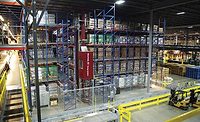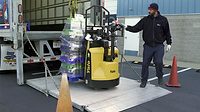Designing solutions for warehouse woes
New technologies address common, upcoming issues


|
|
Westfalia added an employee lift cabin option for storage and retrieval machines for added safety and convenience, the company says. |
From ingredients to finished products to warehouse equipment, new ideas and solutions serve as fuel to keep beverage-makers and distributors going. As industry events such as Pack Expo demonstrate, equipment manufacturers maintain a pulse on the industry to offer new innovations to address current issues and anticipate future trends.
In its Third Quarter 2011 Economic Outlook, the Packaging Machinery Manufacturers Institute (PMMI) reported that the forecast for 2011 has improved slightly, but outlook for 2012 remains unchanged. The report, which is produced for PMMI by The Institute for Trends Research, showed that leading indicator trends point to slower growth for the remainder of the year and into early next year. However, the U.S. leading indicator has not reached its cyclical low.
Its 4 percent rate of change signals slower growth, but not recession, during the upcoming three to four quarters, the association’s report says.
In spite of slow industry growth, PMMI’s Pack Expo conference anticipated a record-breaking show for 2011. PMMI President and Chief Executive Officer Charles D. Yuska attributed some of this year’s performance to the association’s “customer-centric” approach to promoting and marketing this year’s show.
Innovation based on customer demands also inspired the following three warehouse technologies, which were designed to better serve warehouse needs.
Lightweight adapted
For beverage-makers that have made the switch to lightweight packaging, Standard Knapp Inc., Portland, Conn., developed a solution to help reduce product damage. Standard Knapp’s Versatron Soft Catch Servo Case Packer is designed with a two-axis servo system that allows the machine to catch the product while it descends into the case.
“One of the biggest concerns is glass breakage,” says David Lau, manager of case packer engineering for Standard Knapp. ”As glass gets thinner, breakage rates are going to increase, so everybody is out there looking for what people can offer to help eliminate the glass breakage. One of the things that we’ve been looking at is this super-soft catch, which allows us to catch the product as if you’re soft-catching an egg.”
The machine’s lift table moves the case to the upright position and waits for a full grid, the company says. Once the grid is full, the riding strips shift to the side and initiate bottle descent, while the lift table simultaneously moves the case downward on a velocity curve that ultimately achieves the same speed at the point of contact, which is the soft catch, Lau says.
In addition to accommodating thinner-walled glass containers, the Versatron also can help companies that have removed the partitions between bottles in secondary packaging, he says.
The company developed a new prototype that builds on the Versatron’s features, which was on display at Pack Expo along with the standard model. The prototype machine uses a set of grippers or vacuum cups to grab 12- to 24-count bottles and physically lower them into the case. This solution would virtually eliminate the impact and is suited for higher-end products and extremely thin-walled glass materials, Lau explains.
Safety first
Westfalia, York, Pa., expanded its product range with a new storage and retrieval machine (SRM) option with a separate employee lift cabin that is independent from the vertical pallet lift and its load-carrying device. The lift cabin can transport one person to the mast of the SRM without having to use the service ladder.
“In most AS/RS systems, you would go up using the actual load handler that you’d store pallets on, and then you’d put safety devices in place. It’s not technically made for operators to ride; they actually add some safety features to allow that,” says Jon Schultz, vice president of business development for Westfalia Technologies. “What this allows you to do is create a very safe operating environment that’s tailored for allowing an operator, a mechanic or a warehouse operations person to go up and actually inspect the inventory.”
The cabin can be particularly useful for liquor and beer distributors who might need to check inventory numbers or vintages, Schultz says. It also allows for inspection of loads, he says.
“In the case of beverages, there might be a fault due to stretch wrap or a bad pallet that you can go up and inspect and very quickly resolve as opposed to going through some sort of lock-out process and putting it in manual mode,” Schultz says. “So it provides some convenience that you wouldn’t have with a conventional AS/RS system.”
Westfalia offers two models of the new SRM lift cabin: a regular cabin with the controls put in dead man’s mode and another that operates through a mobile control panel. The lift cabin option is available for new SRM customers, but also can be retrofitted with some existing SRMs depending on mast design, the company says.
Productivity in mind
Barcoding Inc., Baltimore, partnered with Wexford, Pa.-based Lucas Systems Inc. to offer Jennifer VoicePlus voice-picking solutions for warehouses. Implemented in more than 40 beverage warehouses, Jennifer VoicePlus is a voice-directed warehouse application that is built to run on mobile computers rather than single-purpose, voice-only hardware. It is optimized for standard mobile computers, which allows customers to run the system on the same models already used for non-voice radio frequency applications, the company says.
“In general, warehouses are investing in information and automation systems that improve the quality and productivity of their operations, but given the tough economy, they want solutions that deliver a quick payback,” says Shane Snyder, vice president of sales for Barcoding Inc. “No one can afford to invest in a technology that will take two or three years to earn a positive return on investment.”
Snyder says voice picking solutions have already been accepted in beverage distribution and the broader supply chain market for the ability to improve warehouse operations. In addition, the Jennifer VoicePlus runs on multi-purpose mobile computers that allow warehouses to use a single, flexible device for traditional barcode scanning and voice applications, Snyder says.
“Jennifer VoicePlus applications can use voice and scanning in a single application, if and when appropriate, which improves efficiency and accuracy beyond what is possible with first-generation voice systems,” Snyder says. “Finally, Jennifer VoicePlus includes sophisticated process management, productivity tracking and other tools that extend traditional warehouse systems.”
The company recently introduced a module called Speedometer that provides real-time productivity feedback to users, including warnings if productivity rates fall below a certain percentage, Snyder says.
“We have seen some customers double productivity after implementing voice, and most customers reduce picking errors by more than
50 percent,” Snyder says. “Our QC/Audit system helps warehouses better target their audit resources and perform audits more efficiently. Our truck loading module ensures the right items get on the right trucks, in addition to providing drivers with more accurate information to improve the delivery process at the customer location.” BI
Looking for a reprint of this article?
From high-res PDFs to custom plaques, order your copy today!






